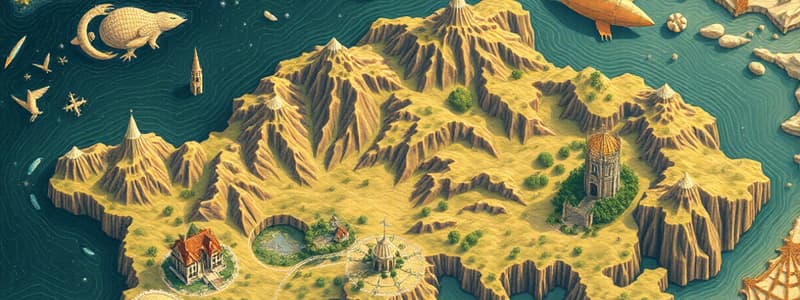Podcast
Questions and Answers
Which type of settlement is characterized by high population density and built-up infrastructure?
Which type of settlement is characterized by high population density and built-up infrastructure?
- Nomadic
- Rural
- Urban (correct)
- Suburban
What type of map would most likely show political boundaries and cities?
What type of map would most likely show political boundaries and cities?
- Thematic Map
- Political Map (correct)
- Weather Map
- Topographic Map
Which concept refers to the systematic practice of measuring land for data gathering?
Which concept refers to the systematic practice of measuring land for data gathering?
- Mapping
- Surveying (correct)
- Geocoding
- Remote Sensing
Which type of climate is characterized by high temperatures and low rainfall?
Which type of climate is characterized by high temperatures and low rainfall?
What does GIS stand for in geographic techniques?
What does GIS stand for in geographic techniques?
Study Notes
Physical Geography
- Landforms: Study of mountains, plains, plateaus, hills, valleys, and deserts.
- Climate: Different types (tropical, arid, temperate) affecting flora and fauna.
- Soil: Types (alluvial, black, red, laterite) and their characteristics.
- Water Bodies: Rivers, lakes, seas, and oceans; their types and significance.
Human Geography
- Population Distribution: Factors affecting population distribution (climate, resources).
- Settlement Patterns: Types of settlements (rural, urban) and their characteristics.
- Cultural Geography: Cultural traits, language, religion, and their spatial distribution.
Economic Geography
- Agriculture: Types (subsistence, commercial) and impact on the economy.
- Industry: Types of industries (primary, secondary, tertiary) and their locations.
- Trade: Global trade patterns and the impact of globalization on economies.
Environmental Geography
- Ecology: Relationship between humans and their environment.
- Conservation: Importance of conserving ecosystems and biodiversity.
- Sustainable Development: Practices that balance economic growth with environmental protection.
Map Reading and Interpretation
- Types of Maps: Physical, political, thematic.
- Scale: Understanding scale and its importance in geography.
- Symbols and Legends: Interpreting symbols used on maps for proper understanding.
Geographic Techniques
- GIS (Geographic Information System): Technology used for mapping and analysis.
- Remote Sensing: Use of satellite images to gather geographic information.
- Surveying: Techniques for measuring land and gathering data.
Important Concepts
- Latitude and Longitude: Fundamentals of locating places on the Earth.
- Time Zones: Understanding time differences across regions due to Earth's rotation.
- Globalization: Impact on geography in terms of cultural exchange and economic activities.
Landforms
- Mountains: Formed by tectonic plate movements, providing unique ecosystems and resources.
- Plains: Flat, low-lying areas, often used for agriculture.
- Plateaus: Elevated, flat areas, with diverse ecosystems and resources.
- Hills: Rounded, elevated landforms, smaller than mountains, often used for farming.
- Valleys: Low-lying areas between hills or mountains.
- Deserts: Areas with low rainfall, characterized by distinct flora and fauna.
Climate
- Tropical Climate: Hot and humid, characterized by rainforests and diverse biodiversity.
- Arid Climate: Dry and hot, with little rainfall, supporting unique desert ecosystems.
- Temperate Climate: Moderate temperatures and rainfall, supporting forests, grasslands and agriculture.
Soil
- Alluvial Soil: Formed by river deposits, rich in nutrients, ideal for farming.
- Black Soil: Formed from volcanic rocks, rich in iron and magnesium, supports cotton agriculture.
- Red Soil: Formed from weathering of crystalline rocks, deficient in nutrients, suited for specific crops.
- Laterite Soil: Formed by weathering of rocks in areas with high rainfall, rich in iron and aluminum oxides, suitable for specific crops.
Water Bodies
- Rivers: Flowing water bodies that transport and regulate water.
- Lakes: Still water bodies, important for biodiversity, recreation, and water supply.
- Seas: Large bodies of salt water connected to oceans, supporting diverse ecosystems and marine life.
- Oceans: Vast bodies of salt water covering most of Earth's surface, regulating climate and supporting marine life.
Population Distribution
- Climate: Influences where people live, with favorable climates attracting higher populations.
- Resources: Accessibility to water, fertile land, and other resources impacts population density.
Settlement Patterns
- Rural Settlements: Characterized by low population density, agriculture, and dependence on land.
- Urban Settlements: Characterized by high population density, industries, and services.
Cultural Geography
- Cultural Traits: Include customs, beliefs, languages, and traditions that define a particular community.
- Language: Affects communication, cultural identity, and social interactions.
- Religion: Influences cultural values, beliefs, and practices, shaping social organization.
Agriculture
- Subsistence Agriculture: Primarily for self-consumption, producing enough to sustain family and community.
- Commercial Agriculture: Focused on production for sale in profit-driven markets.
Industry
- Primary Industry: Extractive industries that obtain raw materials, such as agriculture, mining, and forestry.
- Secondary Industry: Manufacturing industries that convert raw materials into finished products.
- Tertiary Industry: Service industries providing services to individuals and businesses.
Environmental Geography
- Ecology: Studies the interactions between organisms and their environment.
- Conservation: Protecting ecosystems and biodiversity, ensuring sustainable use of natural resources.
- Sustainable Development: Balancing economic growth with environmental protection.
Map Reading and Interpretation
- Physical Maps: Showcase landforms, water bodies, and elevation.
- Political Maps: Show country boundaries, cities, and other political features.
- Thematic Maps: Highlight specific themes like population density, rainfall, or resource distribution.
Geographic Techniques
- GIS (Geographic Information System): Integrates geographical data for analysis and visualization.
- Remote Sensing: Uses satellite images to gather data about Earth's surface.
- Surveying: Measures land and collects data using instruments and techniques.
Important Concepts
- Latitude and Longitude: Uses a grid system to pinpoint locations on Earth.
- Time Zones: Based on Earth's rotation, allowing for consistent timekeeping across the globe.
- Globalization: Increasing interconnectedness between people and economies, shaping cultures and environments.
Studying That Suits You
Use AI to generate personalized quizzes and flashcards to suit your learning preferences.
Description
Test your knowledge on diverse geographical elements including landforms, climate, and soil in Physical Geography. Explore population distribution, settlement patterns, and the economy in Human Geography. This quiz covers essential concepts that shape our world and its environment.



